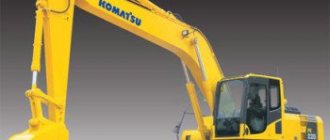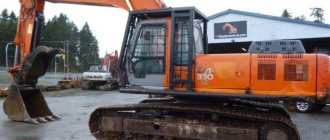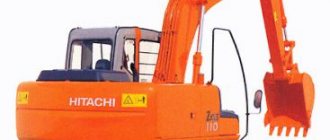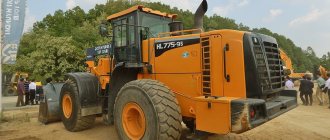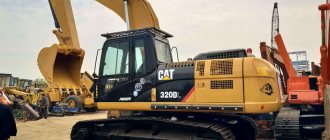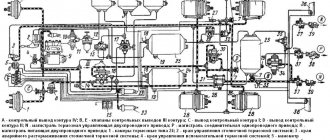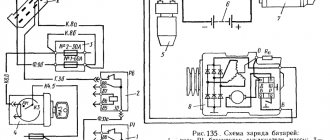The hydraulic cylinder of an excavator is a classic displacement hydraulic engine. It is needed to transform hydraulic energy into mechanical energy, which powers the working mechanisms of an excavator or other special equipment. Such engines are installed on any automotive equipment used in mining, mining, manufacturing, agriculture, life support systems, housing and communal services, etc.
They produce general-purpose hydraulic cylinders that are suitable for various machines in many industries. There are also special-purpose models intended for reclamation, fire-fighting, municipal, earth-moving, lifting, handling and other specialized types of special equipment.
In addition to excavators, hydraulic motors are installed on dump trucks, trucks, graders, truck cranes, tractors, combine harvesters, fire trucks, etc.
Briefly about the represented brands
Komatsu is an international financial and industrial group founded in 1921 in Japan as a construction workshop. Now it is a conglomerate that includes nearly two hundred subsidiaries and consolidated companies with factories and representative offices around the world.
Hitachi or Hitachi is another financial and industrial group originally from Japan, where it was created in 1910. It is now a huge international conglomerate headquartered in Tokyo. The Hitachi Construction Machinery division produces special equipment and spare parts for it.
Error code 1239 1 hitachi
1239-1 is the most unpleasant error.
No pressure in the pump (Fuel leakage). When the pressure applied to the suction control valve is equal to the pressure at 900 rpm, the actual pressure in the fuel manifold is no more than 15 MPa (150 kgf/cm2). Severe engine vibration, uneven idle speed, reduced power output, etc. may be observed. inappropriate increase in speed, dark smoke, excessively high power output. Excessive fuel leakage. The actual pressure in the fuel manifold does not increase to the required value. Your fuel pump is full, and as a less expensive option, the return valve on the fuel rail is full. And you will spoil yourself with gasoline or have already spoiled yourself, and you will also end up using the piston engine in addition to all the fuel.
Now, if memory serves, then at least a liter per minute should definitely gurgle
[QUOTE=Evgen 28;145805]Now, if memory serves, then at least a liter per minute should definitely gurgle /QUOTE]
If the engine is running, then yes, it should gurgle, that’s how it works. And if the injectors are turned off, even with a switch under the seat, or just the wires are pulled back (with the cover removed, it’s easier to see, and anyway, something needs to be changed; it won’t start), then no, it shouldn’t gurgle at all when you turn the starter. Literally three days ago they did this to me and everything worked out, one injector was leaking and they couldn’t start it, and then they found a working one from the old ones, I had 8 more of them,) and that’s it, we’re working. By the way, it turned out that the old fuel pipe (also recently changed and not accidentally thrown away) was bent slightly so that the injectors could be connected without being installed in the head, and they were checked with a storter while rotating the engine. The jets did not flow down the return line at all.
Hello! I don’t want to offend anyone, our specialists are only officials, it’s unlikely that they will do anything. They will change the pump and injectors. If you’re lucky, but if not, suffer as you wish. I’ve already encountered them. The ZX450 could not be repaired for more than six months. All 6 injectors are new, and there are old ones too. I don’t know whether the pump is original or not. Only the same pump and injectors were installed on the Hitachi loader, and from the same batch, so to speak. It has been working for 4 months without problems. The injectors were checked to see if they were leaking, the emergency valve was also dry. The electrician checked all the sensors from the engine to the engine control unit for short circuits and short circuits, fortunately there is a diagram. The voltage at the pressure sensor was 1.1 volts at startup. And when they started it with gasoline, if the pressure rose to 1.30 V, the engine started. Then they didn’t measure the voltage. The engine ran clean, the speed increased. And what’s interesting is that if you turn it off and start it again, the engine started without gasoline! As soon as you start raising the boom, 1239-1, there is black smoke and it stalls. Then again it starts only with gasoline and then, figuratively speaking, you need to pour a bucket. Tomorrow I’ll check the electric pump for performance, how much it gurgles per minute.
If possible, post a tutorial on high-pressure fuel injection pumps [email protected]
Another question, on the ZX 270, two legs on the ECU unit were broken, and now error 108-3 is displayed on the monitor all the time. In principle, this is not a critical error, but management requires that the monitor not show errors. No errors, no problems. How can I restore these legs on the ECU.
Another question, on the ZX 270, two legs on the ECU unit were broken, and now error 108-3 is displayed on the monitor all the time. In principle, this is not a critical error, but management requires that the monitor not show errors. No errors, no problems. How can I restore these legs on the ECU.
The plug was twisted, someone had changed it before us. I don’t argue, maybe they got the wires mixed up themselves. I wasn’t the one who changed the pump. But the main thing is that they found the reason.
To be honest, I was afraid to open the block. The top cover is all on the sealant, you can’t tear it off. Thanks for the help and advice!
Source
Specifications
Technical characteristics, including methods of attachment to the working mechanisms of special equipment, are determined by the design of the hydraulic cylinders. They consist of a sleeve, also called a piston, filled with working fluid, and a rod, which moves in the cavity of the sleeve. In addition to the main structural parts, hydraulic cylinders also include a guide sleeve, a cover, support and guide elements (wipers and sealing collars and rings), as well as lugs at the end of the rod and the opposite end of the piston (liner).
Mounting methods
Hydraulic motors are used in many different areas of production, installed on machines of different sizes, designs and purposes. Therefore, it is important that cylinder models have different options for attaching to the working mechanisms of special equipment.
Models are produced with the following installation methods:
- using articulated bearings and lugs;
- through articulated bearings, lugs and a trunnion on the body;
- on the eye with a hinged bearing, as well as with the preparation of the rear engine cover for welding with the counter element of the working mechanism;
- with preparation of the outer end of the rod for welding with the required part;
- with preparation of the outer end of the rod for welding with the mating elements of the working mechanism, as well as on the eye and with the articulated bearing;
- with preparation of the rear cylinder cover and the outer end of the rod for welding with the counter structural elements of the working mechanism of special equipment.
This variety of fastening methods allows you to reliably and firmly install a hydraulic cylinder on any mechanism of any automotive special equipment, including industrial, road, quarry, construction, agricultural, etc.
Basic parameters
For maximum efficiency and maximum productivity, hydraulic cylinders must create sufficient pressure with the ability to smoothly adjust it. Then it will be possible to perform both rough, large, sweeping movements with a working tool, and smaller, subtle, complex, accurate ones.
The given operational characteristics provide the following technical parameters:
- Nominal pressure. A basic characteristic that generally determines all operational capabilities of the equipment. It expresses the force with which the working fluid can press on the rod, causing it to move. For almost all models of Komatsu and Hitachi hydraulic cylinders presented in the catalog, the nominal pressure is 35 megapascals. This is the maximum value, it is quite sufficient for constant levels of 10, 16, 25 or 32 MPa, and for most peak levels, for example, 20 or 32 MPa.
- Piston diameter. Since this part is also called a sleeve, the parameter also has a second option - the diameter of the sleeve. A piston is a cylindrical cavity, inside of which there is a working fluid and a rod moves. The diameter of this cavity determines the volume of hydraulic mixture that can fit in it. The more working fluid, the higher the nominal pressure can be and the more powerful the engine will be. Depending on where the cylinder is mounted, the diameter of its piston ranges from 120 to 180 mm.
- Rod diameter. A rod is an elongated cylindrical screw that moves inside the piston, interacting with the working fluid in it. The diameter of this screw determines the force required by the hydraulic mixture to push it out. In this case, part of the energy is inevitably spent on the operation of its source itself. However, a rod that is too thin is not the best solution, because then its translational movements in the piston will be hampered. The diameter of the rod is usually about two thirds of the diameter of the piston, that is, from 80 to 130 mm.
- Rod stroke. Indicates the distance to which the rod moves during operation, that is, the depth to which it is immersed in the working fluid. The value of this characteristic must be sufficient for the environment to respond with the necessary effort and communicate the required amount of energy. Rod stroke is naturally limited by the depth of the sleeve cavity and is typically approximately ten times the sleeve diameter. For the models presented in the catalog, this parameter ranges from 1,220 to 1,820 mm.
Such characteristics of hydraulic cylinders as piston diameter and rod stroke directly determine its technical and operational capabilities.
Malfunctions and repairs
Almost all structural elements of hydraulic cylinders are in constant motion during operation. This causes friction of parts against each other, and is also complemented by the abrasive effect of technical materials, for example, mechanical impurities in used hydraulic fluid that was not replaced in time. As a result, the mechanism may fail before its standard service life expires.
This is also facilitated by improper care of equipment, skipping regular scheduled preventive technical inspections, and the use of cheap and low-quality working media, lubricating oils and other liquids for the purpose of primitive economy. An irrational attitude towards technology, for example, regular operation at the limit, also aggravates the situation and shortens the service life of hydraulic cylinders.
Among the main types of hydraulic cylinder malfunctions it is worth noting:
- abrasion of the contacting surfaces of the sleeve and rod due to working friction and the abrasive effect of technical fluids;
- thinning and perforation of sealing materials - for the same reasons;
- loosening and partial unscrewing of internal connections.
Sure external signs of malfunctions are leaks of technical fluids, uncharacteristic sounds, vibration, and rattling of the hydraulic cylinder during operation. The operator of special equipment will notice a sharp, unreasonable and noticeable drop in the power, productivity and lifting capacity of the machine while energy consumption remains at the same level or even increases.
In this case, repairs should be carried out as quickly as possible. Minor faults can be repaired on site using a portable kit. In more serious cases, a high-quality, reliable service center is needed, where they will carry out diagnostics, disassemble the mechanism, clean and wash it with a special composition. Depending on the degree of damage, replacement or restoration of structural elements is possible.
Malfunctions in the HITACHI Zaxis fuel system
Hydraulic excavator class 330-3
We provide consultations upon request and provide free technical support and consultations
call 8 929 5051717
Fuel system
Abnormal fuel manifold pressure (First stage)
The pressure in the fuel manifold is above 185 MPa
Abnormal fuel manifold pressure (Second stage)
The first stage “Abnormal pressure in the fuel manifold” is confirmed, the pressure in the fuel manifold is above 190 MPa.
Abnormal fuel manifold pressure (Excessive pump pressure)
When the DUTY parameter for the suction control valve is set to not lower than 40%, or the set pressure value for the suction control valve is not more than 90 mm 3 /sec, the actual pressure in the fuel manifold is 40 MPa (410 kgf / cm 2 ) above a given value.
Pressure limiting valve open
The pressure limiting valve is open.
No pressure in the pump (Fuel leak)
When the DUTY parameter for the suction control valve is set to no higher than 33%, or the suction control valve pressure is not less than 28000 mm 3 /sec at 1200 rpm, the actual fuel manifold pressure is 50 MPa (510 kgf/cm 2) below the specified value.
No pressure in the pump (Fuel leak)
When the pressure applied to the suction control valve is equal to the pressure at 900 rpm, the actual pressure in the fuel manifold is no more than 15 MPa (150 kgf/cm2)
Supposed signs of malfunctions in the actual operation of the machine
Likely conditions in standby control mode
Fault code (Tech 2)
Significant engine vibration, rough idle speed, decreased power output, inappropriate increase in speed, dark smoke, or excessively high power output may be observed.
Prevents damage to the connection system (pump).
(RP sensor overpressure protection)
Significant engine vibration, rough idle speed, decreased power output, inappropriate increase in speed, dark smoke, or excessively high power output may be observed.
Preventing damage to the connecting system (The pressure is too high because the PR is clogged.)
Significant engine vibration, rough idle speed, decreased power output, inappropriate increase in speed, dark smoke, or excessively high power output may be observed.
Error code 1239 1 hitachi
1239-1 is the most unpleasant error. No pressure in the pump (Fuel leakage). When the pressure applied to the suction control valve is equal to the pressure at 900 rpm, the actual pressure in the fuel manifold is no more than 15 MPa (150 kgf/cm2). Severe engine vibration, uneven idle speed, reduced power output, etc. may be observed. inappropriate increase in speed, dark smoke, excessively high power output. Excessive fuel leakage. The actual pressure in the fuel manifold does not increase to the required value.
Your fuel pump is full, and as a less expensive option, the return valve on the fuel rail is full. And you will spoil yourself with gasoline or have already spoiled yourself, and you will also end up using the piston engine in addition to all the fuel.
Now, if memory serves, then at least a liter per minute should definitely gurgle
[QUOTE=Evgen 28;145805]Now, if memory serves, then at least a liter per minute should definitely gurgle /QUOTE]
If the engine is running, then yes, it should gurgle, that’s how it works. And if the injectors are turned off, even with a switch under the seat, or just the wires are pulled back (with the cover removed, it’s easier to see, and anyway, something needs to be changed; it won’t start), then no, it shouldn’t gurgle at all when you turn the starter. Literally three days ago they did this to me and everything worked out, one injector was leaking and they couldn’t start it, and then they found a working one from the old ones, I had 8 more of them,) and that’s it, we’re working. By the way, it turned out that the old fuel pipe (also recently changed and not accidentally thrown away) was bent slightly so that the injectors could be connected without being installed in the head, and they were checked with a storter while rotating the engine. The jets did not flow down the return line at all.
Hello! I don’t want to offend anyone, our specialists are only officials, it’s unlikely that they will do anything. They will change the pump and injectors. If you’re lucky, but if not, suffer as you wish. I’ve already encountered them. The ZX450 could not be repaired for more than six months. All 6 injectors are new, and there are old ones too. I don’t know whether the pump is original or not. Only the same pump and injectors were installed on the Hitachi loader, and from the same batch, so to speak. It has been working for 4 months without problems. The injectors were checked to see if they were leaking, the emergency valve was also dry. The electrician checked all the sensors from the engine to the engine control unit for short circuits and short circuits, fortunately there is a diagram. The voltage at the pressure sensor was 1.1 volts at startup. And when they started it with gasoline, if the pressure rose to 1.30 V, the engine started. Then they didn’t measure the voltage. The engine ran clean, the speed increased. And what’s interesting is that if you turn it off and start it again, the engine started without gasoline! As soon as you start raising the boom, 1239-1, there is black smoke and it stalls. Then again it starts only with gasoline and then, figuratively speaking, you need to pour a bucket. Tomorrow I’ll check the electric pump for performance, how much it gurgles per minute.
If possible, post a tutorial on high-pressure fuel injection pumps [email protected]
Another question, on the ZX 270, two legs on the ECU unit were broken, and now error 108-3 is displayed on the monitor all the time. In principle, this is not a critical error, but management requires that the monitor not show errors. No errors, no problems. How can I restore these legs on the ECU.
Another question, on the ZX 270, two legs on the ECU unit were broken, and now error 108-3 is displayed on the monitor all the time. In principle, this is not a critical error, but management requires that the monitor not show errors. No errors, no problems. How can I restore these legs on the ECU.
The plug was twisted, someone had changed it before us. I don’t argue, maybe they got the wires mixed up themselves. I wasn’t the one who changed the pump. But the main thing is that they found the reason.
To be honest, I was afraid to open the block. The top cover is all on the sealant, you can’t tear it off. Thanks for the help and advice!
Source
Range
The catalog on the website contains more than a hundred names of mechanisms for various purposes, as well as spare parts for them. Our company supplies equipment from two leading global manufacturers:
- Hydraulic cylinders for Komatsu excavators. The catalog contains more than ten models of hydraulic pistons for equipment of this brand. There are cylinders for the bucket, counterweight, handle, blade lift (boom), as well as parts for them, for example, a bushing for the blade lift mechanism. The models have the following applicability: PC200-7, PC200-8, PC300-7 and a number of other values. Most Komatsu mechanisms are only suitable for special equipment of the same brand.
- Hitachi excavator hydraulic cylinders. The catalog reflects about a hundred models of hydraulic motors of the Hitachi brand. These are mechanisms for buckets, booms, handles, as well as spare parts. The products presented in the catalog have the applicability of ZX-180W, ZX240-3, ZX240-5G EX-220-5, EX-120-5, PC200-7, PC200-8, ZX450, EX400-5 and some other values. Among the products of the Hitachi brand, hydraulic cylinders for universal use predominate.
The catalog also presents several models of Hyundai brand equipment. It is owned by an international conglomerate of five commercial groups founded in 1947 in South Korea. We supply universal hydraulic cylinders for buckets manufactured under this brand.
HITACHI excavator.Error codes
Rental of Special Equipment Moscow and Moscow region Telegram channel
Hitachi Excavator Error Code:
11100-2 engine speed is abnormal
11101-3 High pressure engine speed controller sensor is abnormal
11101-4 Engine speed control handle sensor, low pressure level
11200-3 Malfunction of high pressure pressure sensor in pump 1
11200-4 Pump 1 Oil pressure sensor low pressure fault
11202-3 Pump 2 Oil pressure sensor abnormal high pressure
11202-4 Pump 2 Oil pressure sensor low pressure fault
11206-3 Malfunction of pressure sensor of pump 1 high pressure pump
11206-4 Malfunction of low pressure pressure sensor of pump 1 pump
11208-3 Malfunction of pressure sensor of pump 2 high pressure pump
11208-4 Malfunction of pressure sensor of pump 2 low pressure pump
11301-3 High Pressure Rotary Pilot Sensor
11301-4 Rotary pressure sensor low pressure fault
11302-3 Malfunction of the high pressure pressure sensor of the boom lift pilot
11302-4 Malfunction of low pressure boom lift control pressure sensor
11303-3 Stick removes high pressure deviation of pilot pressure sensor
11303-4 Low pressure sensor handle retract lever handle
11304-3 Walking pressure sensor high pressure fault
11304-4 Walking pressure sensor low pressure alarm
11307-3 Emergency deviation of the high pressure pressure sensor of the front end working body
11307-4 Low pressure sensor of the working pressure sensor of the front end of the working device
Types of hydraulic cylinders
At the installation location
The classification of hydraulic cylinders by installation location is relevant only for excavator models. The varieties differ in the main structural parts of the working mechanism, the working movement of which they provide. Highlight:
- Excavator boom lift hydraulic cylinder. The boom is the lower part of the working mechanism, to which a handle with a bucket at the end is attached to the top. A hydraulic motor is needed here to lift the boom and (in some models) rotate around its axis, which makes it possible to roughly manipulate the load in the bucket.
- Excavator handle hydraulic cylinder. The main tool for managing work operations. It is necessary to change the angle of the handle relative to the boom to the required height. This angle ensures that working actions are performed with a load held in the bucket.
- Excavator bucket hydraulic cylinder. The bucket is movably attached to the end of the handle and at the same time captures the load, raking it with its jagged edge from the surface of the earth, and holds it in its cavity for some time. To perform all the necessary movements, it is equipped with its own hydraulic piston.
Models designed for working mechanisms of other types of special equipment have similar differences. Thus, truck cranes also have a vertical base and a horizontal boom with a load-handling member.
By type of design
This classification is basic and is based on the internal features of the mechanism. From the point of view of the design of hydraulic motors, they are divided into two classes:
- Single-sided execution. In devices of this type, the movement of the piston under the influence of the working medium is possible only in one direction. They are installed on special equipment that performs only a limited set of movements in one direction. Due to its simpler design, it achieves greater strength and power.
- Double-sided design. In hydraulic motors of this model, the rod can move in two opposite directions. From the outside it looks like the working mechanism of the equipment is capable of reciprocating movements. They produce products with single-sided, double-sided, and telescopic rods.
The scope of application of double-acting hydraulic cylinders is much wider than that of their single-acting counterparts. For example, double-sided hydraulic cylinders with a single-sided rod are often installed on excavators of almost any brand.
By main functions
The tasks solved by hydraulic cylinders in all areas of their application are divided into three categories:
- Activating the lever mechanisms with which the working equipment is equipped, performing other cyclically repeated simple movements that constitute the useful operation of the equipment. Such work is typical for front-end and timber loaders, as well as single-bucket excavators.
- Moving the working parts of special equipment and performing other related actions during this movement, which constitutes the useful work of the machine. Such problems are solved by motor graders, bulldozers, scrapers, etc.
- Bringing the working parts of special equipment into the position necessary for its full operation, as well as installing outriggers that ensure a stable condition of the equipment. This work is performed by truck cranes, various lifting and handling equipment.
In the same field of application, special equipment with hydraulic cylinders of all three types can be used. For example, in construction, truck cranes lift building materials to the required height, excavators are used to dig foundation pits, and a grader levels the construction site.
According to climatic version
Cylinders are produced adjusted for the average annual temperature and humidity of the environment:
- the version for temperate climates is suitable for use in the mid-latitudes of European Russia, including almost the entire Urals, in the south of Siberia and the Far East;
- the option for cold conditions will be optimal for the European North of Russia, the territories of Northern and Central Siberia and most of the Far East;
- versions for dry tropical climatic zones in Russia can be used in the steppe zones of the Southern Urals and Middle Volga region, in the North Caucasus;
- options for humid tropical conditions are optimal in a very small area - the Black Sea coast of the Krasnodar Territory.
It also makes sense to use hydraulic cylinders in climatic design for dry tropics in the central part of the Crimean peninsula, remote from the coast. Versions for the humid tropics are suitable for Sevastopol and the coastal regions of Crimea.
